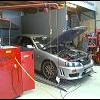How Do 550cc Injectors Make 300rwkw On An Rb25det?
Announcements
-
Similar Content
-
Latest Posts
-
Ok, so first round of maintenance done. I didn't get much history with the car but I know it was well looked after. That isn't enough for me though, so ... I had to do the oil filter housing gasket. It was leaking a lot, and also as part of that I did the anti-return valve and the VANOS oil line (from HEL). But, then I got hit with the while-ya-in-there's. Did both accessory and A/C belts, tensioners and pulley. The accessory belt that came off had a huge hole in it, like somebody hung it up with a nail. The pulley and tensioners seem ok, so I'll keep those just in case. I did water pump and pump pulley. The water pump had a small bit of play so timing was good. I also did fan clutch. I don't know how to test the old one but between the water pump and the fan clutch the car is running a little bit cooler (not much ~2 - 3 degrees maybe) so good result. Unfortunately the thermostat and housing didn't turn up in time so I'll shelve those. I have no concerns at all on the current ones. Then I spent what seemed like 40 days and 40 nights bleeding the air from the cooling system. She also got new air filter, fuel filter and did a Mobil 1 change with oil filter. Hilariously, not an hour after telling my wife how proud I was of myself to be going slowly and meticulously and making sure everything was torqued and nothing missing I went and started it without the oil filter in. The car complained immediately of no pressure and after only a few seconds I turned it off and discovered a shit tonne of oil on the driveway. Sigh. I've driven it since and thankfully doesn't seem to be any problems. AND THEN during the test drive a ratchet extension fell into the battery area in the boot and JAMMED right next to the positive terminal and the car body. Like, just touching it made sparks and it was jammed in there. So, almost killed the engine and then almost burned the car to a crisp. Good start. This was the rails under the splash guards. So stoked, she's straight as and super clean. No rust anywhere. There was a heap of caked dirt that I removed but otherwise looked great. All 4 jacking points are perfect. Next I want to service the gearbox. Sometimes it's a little reluctant to shift up and I'm hoping a fluid change will sort it. I also have 4 new rear subframe bushes. They're as big as a toddler. I'm renting a tool to help put them in. I can't wait for this because its a bit crashy back there at the moment.
-
By Dose Pipe Sutututu · Posted
Remember when those donkeys kept using freedom units and smashed that satellite to bits on the moon? NASA has their brain switched on and uses the metric system. -
Don't use "gasless MIG" (FCAW) you want to use proper MIG. FCAW burns a few hundred degrees hotter than MIG will for mild steel. It is a true ball ache for sheet metal. New MIG / TIG machines even have features like "Spot Weld" as well as "Automatic" settings. Plenty of people say for DIY home hobby, the auto machines are pretty good for 95% of welding. I personally, I'm a sucker for punishment and wanting to dial it in, and be able to adjust the machine. Mainly because I used to MIG weld for a living, and being able to tweak and tune things ever so slightly was my preference. Hence when I bought my ACDC TIG, it has all the adjustments for everything and no "easy" mode. Ha ha I have stick, MIG, "gaslessMIG" and ACDC TIG at home. Out of them, if you're doing mild steel sheet metal repair, and want to do mild steel exhausts, go MIG. If you're thinking you'll want to get into doing some aluminium stuff, or stainless steel, get an ACDC TIG with HF start. If you can, get one with a foot pedal too. My MIG machine is a UniMIG, and my Stick/TIG is CigWeld. If I were buying another machine, I'd buy another CIGWeld. Lots of people having issues with UniMIG, and them not wanting to cover warranty. Everything has to go back to UNIMig themselves. CIGWeld, I've had to use their warranty on my machine for a gas leak, they have repair centres everywhere, (contracted authorised repair centres). First repair place I used were hopeless, but the second place were amazing. Warranty process itself super easy, and second repair place was telling me CigWeld actually cover in their warranty, upto an hour of techs time to help you with your machine, and going through the settings and helping teach you the machine. UniMIG keep trying to get out of replacing motherboards on 12 month old machines. TLDR, mild steel sheet welding, buy a MIG. my vote is CigWeld for brand.
-
I guess that's what happens when someone can't convert metric to freedom units to machine something. 😛
-
I've watched some vids and the technique seems to be to butt the sheets up to one another and use MIG to spot weld and slowly fill in the spots until its eventually all sealed. No runs as you would normally do, as there's too much heat generated that way. Yeah my stick welds are terrible these days because its been so long since i've done any of it. I expect to be spending many hours practicing
-









Recommended Posts
Create an account or sign in to comment
You need to be a member in order to leave a comment
Create an account
Sign up for a new account in our community. It's easy!
Register a new accountSign in
Already have an account? Sign in here.
Sign In Now